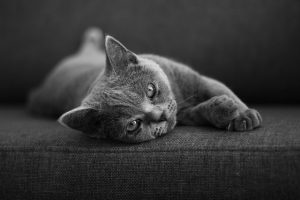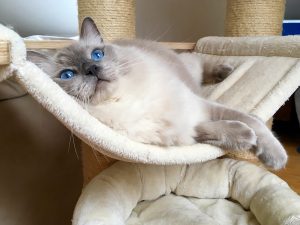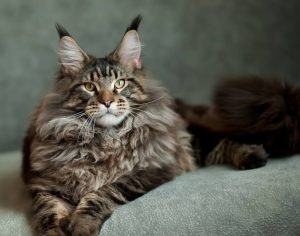World’s Most Famous Large Cat Breeds
 Fact-checked
Fact-checked
Last Updated: February 2, 2023
Many large cat breeds make excellent pets. Depending on your lifestyle and character you can choose a cat breed that is more cuddly and tranquil or one that is more playful and willing to entertain your kids.
In order to help you make up your mind and choose the best option for your family, we’ve listed the 10 most famous large breeds, as well as everything you need to know about their character and appearance.
How Many Large Cat Breeds Are There?
The total number of cat breeds varies according to the different international cat registers and other organizations. Although Encyclopedia Britannica lists only 15 cat breeds, The International Cat Association recognizes 71 different cat breeds. Many other well-recognized associations and registers fall somewhere between those two numbers.
In this article, we’re going to take a closer look at the most prominent large breeds.
| DID YOU KNOW: A house cat’s genetic makeup is nearly 95.6% identical to a tiger’s. |
Types of Large Domestic Cats You Can Adopt
Depending on whether you’re looking for a cuddly companion to sit back and relax with or an energetic cat that will enjoy playing with the kids, you will probably choose a different breed. No matter what type of pet you plan on adopting, you’ll find some great choices in the list below:
-
British Shorthair
Weight: 9-17 pounds (males), 7-12 pounds (females)
Height: 12-14 inches
Personality: Calm and adaptable
Life expectancy: 12-20 years
The British Shorthair is a very calm breed. That’s why it is often compared to a teddy bear, which is perfect for families with children or adults who prefer an easy-going companion. These types of large domestic cats are also suitable for working individuals as they are quite independent. However, in such cases, it’s always better to have two cats to keep each other company.
A British Shorthair most often has a blue-gray coat, but they also come in different colors and patterns. These cats have a tendency to gain weight, but if their diet is controlled and well balanced, they’ll be just fine.
A fun fact about the British Shorthair is that while it’s the United Kingdom’s favorite breed, but it doesn’t originate on the island. This is one of the large house cat breeds brought to the British Isles by the Romans.
-
Norwegian Forest
Weight: 12-18 pounds (males), 8-12 pounds (females)
Height: 9-12 inches
Personality: Loving and independent
Life expectancy: 13-20 years
The Norwegian forest cat is large and affectionate which makes it suitable for a family pet. Among the fans of the Norwegian forest, it is also known as “Wedgie”. These types of cats are instantly recognizable by their calm and gentle temperament and huge size.
It has a strong and muscular appearance with large paws and a fluffy, thick coat that is water-resistant, adapted for the rough Norwegian winters. This is one of the large domestic cat breeds that have a dense undercoat that keeps them warm, but it also requires brushing. In fact, their winter undercoat molts in the spring.
Their coat color variations includes black, white, red, blue, cream, gold, and silver. Also, they can be found in tortoiseshell, bicolor, solid, and tabby fur patterns and their eyes can be various shades of green, copper, or gold. Wedgies are typically calm, friendly, and gentle cats that can adapt to various lifestyles and families. Moreover, they are good with kids and other animals.
-
Pixiebob
Weight: 11-14 pounds (males), 9-11 pounds (females)
Height: 9-13 inches
Personality: Loyal and active
Life expectancy: 13-15 years
Pixiebobs are among the big domestic cat breeds that look wild because they’re thought to have descended from a barn cat and a bobcat. Yet, in character, they are anything but wild. This cat breed is suitable for households with kids and other pets because they are always willing to join in the fun, which makes them great playmates.
With a thick double coat, Pixiebobs require extra grooming, in order to avoid excessive shedding and matting.
Generally, they have a striped or mackerel coat pattern. Occasionally, its stripes are accompanied by rosettes that give the authentic bobcat look. The coat color of these big house cat breeds can vary, but most are light gray, tawny, or reddish in appearance.
-
Turkish Van
Weight: 10-20 pounds
Height: 10-14 inches
Personality: Smart and social
Life expectancy: 13-17 years
The Turkish Van cats are known for their strength, intelligence, and love for swimming; they’ve even earned the nickname “The Swimming Cat”. This type of cat breed is very rare, so if you have a chance of adopting one, you should be a proud owner. They bond very well with humans and can be very playful.
They have soft water-resistant coats that allow them to enjoy being in the water. They are among the rare large breeds of domestic cats that can stay in the water for long periods of time and they come out relatively dry.
These cats have unusual markings, named the “Van pattern”, which consists of an almost all-white body with a colored tail and face. Their bushy, squirrel-like tails come in brown and red colors.
-
Ragamuffin
Weight: 14-20 pounds (males), 8-13 pounds (females)
Height: 10-15 inches
Personality: Patient and doting
Life expectancy: 12-16 years
Ragamuffins are great companions for introverts and seniors. These cats are cuddlers and enjoy playing with their favorite person. A strong piece of advice for Ragamuffins’ owners is to keep their pets indoors, due to their tendency to trust easily.
Besides being lovable, it’s important to remember that Ragamuffins are among the big house cat breeds that can make a huge mess in your home, so be prepared for some serious cleaning up due to their shedding.
The Ragamuffin is closely related to the Ragdoll, another large cat breed, and they share similar characteristics. Ragamuffins are very lovable and mellow; they’re also known for their docile nature and thick coat. Typically, they have a friendly overall expression with rounded, large eyes. Ragamuffins can be found in a variety of colors and patterns.
A fun fact about this breed is that they’re born white and develop their color and pattern over time.
-
Ragdoll
Weight: 15-20 pounds (males), 10-15 pounds (females)
Height: 9-11 inches
Personality: Sweet and patient
Life expectancy: 13-18 years
This giant cat breed earned its name because of its affectionate, docile, and cuddly nature. All of this makes them ideal for families with kids or for someone who is in need of loving cat therapy. Unlike British Shorthairs, Ragdolls enjoy being picked up and carried around.
As a Ragdoll’s owner, you need to engage them constantly in interactive playtime, in order to help them avoid obesity. Due to their charming nature, soft coats, and big blue eyes, these felines are one of the most popular cat breeds, especially in the UK.
A fun fact about this giant cat breed is that all Ragdolls are all descended from a longhaired white kitten – Josephine – mother of the first Ragdolls kittens in the 1960s.
-
Savannah
Weight: 13-23 pounds (males), 11-20 pounds (females)
Height: 10-17 inches
Personality: Outgoing and energetic
Life expectancy: 12-15 years
In recent years, this cat breed has come under serious examination to determine whether it actually qualifies as a domesticated cat, because it’s a mix between the wild Serval cat and the domestic Siamese. The Savannah’s exotic and leopard-like appearance makes it a desired cat breed among big cat enthusiasts.
While many large domestic cat breeds are known for their weight, the Savannah cat is known for its long and lanky body.
Reminiscent of their African Serval ancestors, Savannahs are generally brown, black, or silver tabbies with dark brown or black spots. Some of them may sport smoked patterns or lighter colors. Savannahs require less grooming than long-haired cats, as they don’t shed that much. Because of their positive energy and playful nature, they might often get into a mess and need a bath, but fortunately, they love water.
-
Siberian

Weight: 12-20 pounds
Height: 10-12 inches
Personality: Intelligent and mellow
Life expectancy: 10-18 years
Native to Russia, the Siberian cat is one of the biggest cat breeds that is built for cold climates, just like the Norwegian forest cat. The Siberians’ long and triple-layered coats provide them with warmth and protection. These cats are very gentle and mellow, so you can play with them for hours.
Siberian cat owners need to be aware that their pet’s triple-layered fur requires regular brushing. However, the brushing routine will be awesome for bonding with your kitty, because the Siberian cats’ friendly nature needs a lot of time together with their humans.
These huge cats are among the breeds that are known by several names; they might be referred to as Moscow Longhairs or Siberian Forest Cats.
-
Selkirk Rex
Weight: 6-16 pounds
Height: 9-11 inches
Personality: Sociable and affectionate
Life expectancy: 12-15 years
Prized for their unusual curly coats, the Selkirk Rex cats are among only four cat breeds with wavy fur. This curly-haired cat has a warm and loving disposition and it comes in both long and short-haired variants.
If your kids dream about having a live Teddy bear, a Selkirk Rex will be the right choice. These large, cuddly pets are characterized by their cute round heads, big eyes, and curly fur that come in various colors and patterns. These types of big house cats are loving, intelligent, easy-going, and get along with people and other pets.
The Selkirk Rex cats are sometimes called “the cat in sheep’s clothing” because of their curly and dense coats which can easily be mistaken for wool. Nevertheless, they don’t require brushing often, as it may straighten their curls.
-
Maine Coon
Weight: 18-25 pounds (males), 12-15 pounds (females)
Height: 10-16 inches
Personality: Sweet and smart
Life expectancy: 12-20 years
Maine Coons are nicknamed “the dogs of the cat world” as they are very family-friendly, as well as extremely intelligent and interactive. Because of these characteristics, Maine Coons are one of the best large house cat breeds for children. Also, they want to be included in all the family’s activities which can make them very sociable pets.
They are one of the largest domestic breeds and they have big ears and ear tufts. They’re sturdy and furry cats, built to withstand harsh winters in the American Northeast. However, before you decide to adopt a Maine Coon, make sure that you’re ready to bathe and brush them frequently and give them a lot of attention.
A fun fact about them is that Maine Coons don’t meow like other cats, they yowl.
What Should You Know Before Adopting a Large House Cat?
If you plan on adopting a large cat, you need to consider some basic things such as the cat’s age, as well as whether your home will be more suitable for some of the smaller breeds. Another important thing is the cat’s breed and personality and how well it will get along with your family members.
Once you decide what breed you’ll adopt, you need to do thorough research about how much you should feed your cat and whether it can eat some human food. If you are adopting a grown cat and not a kitten, then you should also search for some of the top food for senior cats. Moreover, it’s always a good idea to get pet insurance for your large house cat.
| DID YOU KNOW: Creme Puff was the oldest cat that has ever lived. He died in 2005 at the age of 38. |
Conclusion
Before you decide what cat breed you want to adopt, research thoroughly and evaluate whether your house is big enough for a larger cat. Most types of cats want companionship, so if you are away from home most of the time, you need to have someone at home to take care of your pet.
FAQ
The Maine Coon is the largest domestic cat breed with an average weight of between 18-25 pounds. A Maine Coon named Barivel holds the Guinness World Record for being the longest cat. It measures an impressive 3 ft and 11.2 in from head to tail.
There isn’t a particular breed called the tiger cat; this name is given to various cats that have stripes (such as tabby cats) and bear a resemblance to tigers.
Both of these large cat breeds can look like tiny wild cats, but the Bengal cats have spotted fur, while the Toyger boasts vertical stripes. Their coats are very similar in quality, both having plush, velvety hair. The Toyger has a standard striped appearance whereas the Bengal comes in various colors and markings.









![How Many Marriages End in Divorce [Fascinating Facts and Stats]](https://review42.com/wp-content/uploads/2022/07/How-many-marriages-end-in-divorce.png)
![How Much Do Flight Attendants Make? [Latest Data for 2024]](https://review42.com/wp-content/uploads/2022/06/feature-image-56-how-much-do-flight-attendants-make.jpg)
![How Many Websites Are There? [2024’s Data]](https://review42.com/wp-content/uploads/2022/05/feature-image-55-how-many-websites-are-there.jpg)

![Average Gas Prices by State in the US [2024 Data]](https://review42.com/wp-content/uploads/2022/03/feature-image-51-average-gas-price-by-state.jpg)




